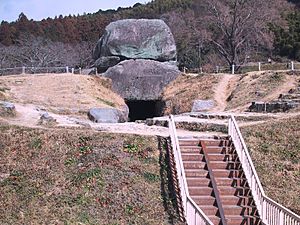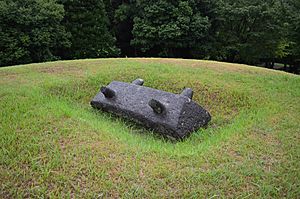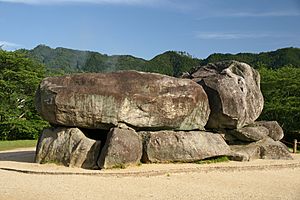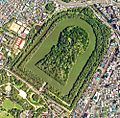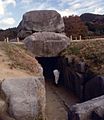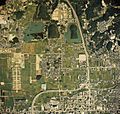Kofun facts for kids
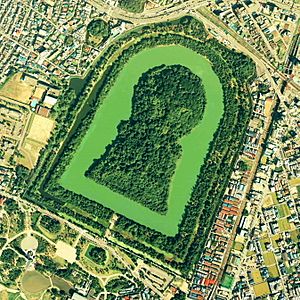

Kofun are megalithic tombs or tumuli in Japan, constructed between the early 3rd century and the early 7th century AD. The term Kofun is the origin of the name of the Kofun period, which indicates the middle 3rd century to early-middle 6th century.
Many Kofun have distinctive keyhole-shaped mounds which are unique to ancient Japan. The Mozu-Furuichi kofungun or tumulus clusters were inscribed on the UNESCO World Heritage List in 2019, while Ishibutai Kofun is one of a number in Asuka-Fujiwara residing on the Tentative List.
Contents
Overview
The kofun have assumed various shapes throughout history. The most common type of kofun is known as a zenpō-kōen-fun, which is shaped like a keyhole, having one square end and one circular end, when viewed from above. There are also circular-type and square-type kofun. Orientation of kofun is not specified. For example, in the Saki Kofun group, all of the circular parts are facing north, but there is no such formation in the Yanagimoto kofun group. Haniwa, terracotta figures, were arrayed above and in the surroundings to protect the sacred areas.
Kofun range from several metres to over 400m long. The largest, which has been attributed to Emperor Nintoku, is Daisen Kofun in Sakai City, Osaka Prefecture.
The funeral chamber was located beneath the round part and comprised a group of megaliths. In 1972, the unlooted Takamatsuzuka Tomb was found in Asuka, and some details of the discovery were revealed. Inside the tightly assembled rocks, white lime plasters were pasted, and colored pictures depict the 'Asuka Beauties' of the court as well as constellations.
A stone coffin was placed in the chamber, and accessories, swords, and bronze mirrors were laid both inside and outside the coffin. The wall paintings have been designated national treasures and the grave goods as important cultural property, while the burial mound is on the special historic site.
Kofun burial mounds and their remains have been found all over Japan, including remote islands such as Nishinoshima.
A total of 161,560 kofun tomb sites have been found as of 2001. Hyōgo Prefecture has the most of all prefectures (16,577 sites), and Chiba Prefecture has the second most (13,112 sites).
Related pages
- William Gowland, English engineer who made the first survey for Saki kofun group
- Ernest Satow, English diplomat who wrote about kofun in Kozuke for the Asiatic Society of Japan
Images for kids
-
Daisen Kofun, the largest of all kofun, one of many tumuli in the Mozu kofungun, Sakai, Osaka Prefecture (5th century)
-
The stone chamber of Ishibutai Kofun, said to be the tomb of Soga no Umako, Asuka, Nara Prefecture (7th century)
-
Panoramic view of Hashinaka Kofun in Sakurai, Nara
-
An example of keyhole-shaped mound in the Early Kofun period which was drawn in 3DCG. (Gosashi Kofun (Nara, Nara), 4th century)
-
An example of keyhole-shaped mound in the Mid-Kofun period which was drawn in 3DCG. (Nakatsuyama Kofun (Fujiidera, Osaka), 5th century)
-
An example of keyhole-shaped mound in the Late Kofun period which was drawn in 3DCG. (Danpusan Kofun (Nagoya), 6th century)
-
Saki Tatanami Kofun Group and the Heijō-kyō site, Nara Prefecture, 4th century
See also
 In Spanish: Kofun para niños
In Spanish: Kofun para niños


